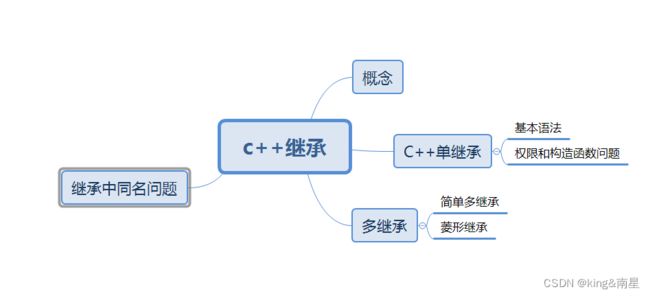c++继承
1.概念
- c++继承代表父类属性在子类中会存在一份。理解起来为生物学的继承即可,子承父业,传承血脉
- ==继承:==子类中不会产生新的属性,派生子类会有新属性产生。继承分为父类和子类,派生分为基类和派生类
2.c++单继承
1.c++继承的基本语法
class 父类{};
class 子类名:继承方式 父类名
{
};
//继承方式
//所谓的权限限定词
//public protected privatr
//公有继承 保护继承 私有继承
2.权限和构造函数问题+
-
继承中权限问题:代表就是继承下来的属性在子类中的呈现
继承方式 public继承 protected继承 private继承 public public protected private protected protected protected private private 不可访问 不可访问 不可访问 - 继承方式只能增强权限
- 父类当中私有属性,无论采用什么继承方式,子类都不可以直接访问
-
继承中的构造函数
- 继承下来的属性必须要通过父类的构造函数去初始化
- 子类的构造函数必须要采用初始化参数列表的方式调用父类的构造函数
- 构造顺序:优先构造父类,再构造子类
#include
#include
using namespace std;
class MM
{
public:
string name;
MM(string name,int age,int money):name(name),age(age),money(money){}
int Getmoney()
{
return this->money;
}
protected:
int age;
private:
int money;
};
class Son:public MM
{
public:
Son(string name,int age,int money,int num):MM(name,age,money),num(num){}
void print()
{
cout << name << "\t" << age << "\t" << Getmoney() << "\t" << num << endl;
}
protected:
int num;
};
int main()
{
Son son("king", 19, 100, 1001);
son.print();
return 0;
}
3.c++多继承
1.简单多继承
- 存在两个或者是两个以上的父类称之为多继承
- 构造顺序问题:只和继承顺序有关,和初始化参数列表一点关系都没有
#include
#include
using namespace std;
class MM
{
public:
MM(string firstMMname,string seconedMMname)
{
this->firstMMname = firstMMname;
this->seconedMMname = seconedMMname;
}
protected:
string firstMMname;
string seconedMMname;
};
class GG
{
public:
GG(string firstGGname, string seconedGGname)
{
this->firstGGname = firstGGname;
this->seconedGGname = seconedGGname;
}
protected:
string firstGGname;
string seconedGGname;
};
class son:public MM,protected GG
{
public:
son(string firstMMname, string seconedMMname, string firstGGname,
string seconedGGname, string seconedsonname) :
MM(firstMMname, seconedMMname), GG(firstGGname, seconedGGname)
{
this->firstsonname = firstMMname + firstGGname;
this->seconedsonname = seconedsonname;
}
void print()
{
cout << (firstsonname + seconedsonname) << endl;
}
protected:
string firstsonname;
string seconedsonname;
};
using namespace std;
int main()
{
son son("K", "i", "n", "g", "_");
son.print();
return 0;
}
2.菱心继承
-
继承无论被继承多少次,属性一直都在,所以一般类不能被继承很多层。继承太多次数,会导致子类臃肿
[外链图片转存失败,源站可能有防盗链机制,建议将图片保存下来直接上传(img-dUb43bqh-1673712417658)(./image/%E8%8F%B1%E5%BF%83%E7%BB%A7%E6%89%BF.png)]
#include
using namespace std;
class A
{
public:
A(int a):a(a){}
protected:
int a;
};
class B:virtual public A
{
public:
B(int a,int b):A(a),b(b){}
protected:
int b;
};
class C:virtual public A
{
public:
C(int a,int c):A(a),c(c){}
protected:
int c;
};
class D:public B,public C
{
public:
D(int a,int b,int c,int d):B(a,b),C(a,b),A(a),d(d){}
D():B(1,2),C(1,5),A(90),d(33){} //a来自爷爷
void print()
{
cout << a << endl;
cout << b << endl;
cout << c << endl;
cout << d << endl;
cout << A::a << endl;
}
protected:
int d;
};
int main()
{
D d(1, 2, 3, 4);
d.print();
D x;
x.print();
return 0;
}
4.c++继承中的同名问题
- 没有用类名限定的基础上,就近原则,在哪个类里调用哪个类的方法
- 用类名限定,可以访问指定类中的成员
- 类指针被子类对象初始化
- 父类没有
virtual,就看指针类型- 有
virtual,就看对象类型
#include
#include
using namespace std;
class MM
{
public:
void print()
{
cout << "MM" << endl;
}
protected:
string name = "MM";
};
class Son:public MM
{
public:
void print()
{
cout << "son" << endl;
cout << name << endl; //就近原则
}
protected:
string name = "son";
};
int main()
{
Son son;
son.print();
Son* pson = new Son;
pson->print(); //覆盖-->正常调用,无法访问父类同名
pson->MM::print(); //类名限定访问
//非正常调用
MM* pmm = new Son; //c++允许父类指针被子类指针初始化
pmm->print(); //virtual
//父类指针不能访问子类中父类没有属性
//注意点: 子类指针被父类对象初始化,有危险。一般不被允许
return 0;
}
